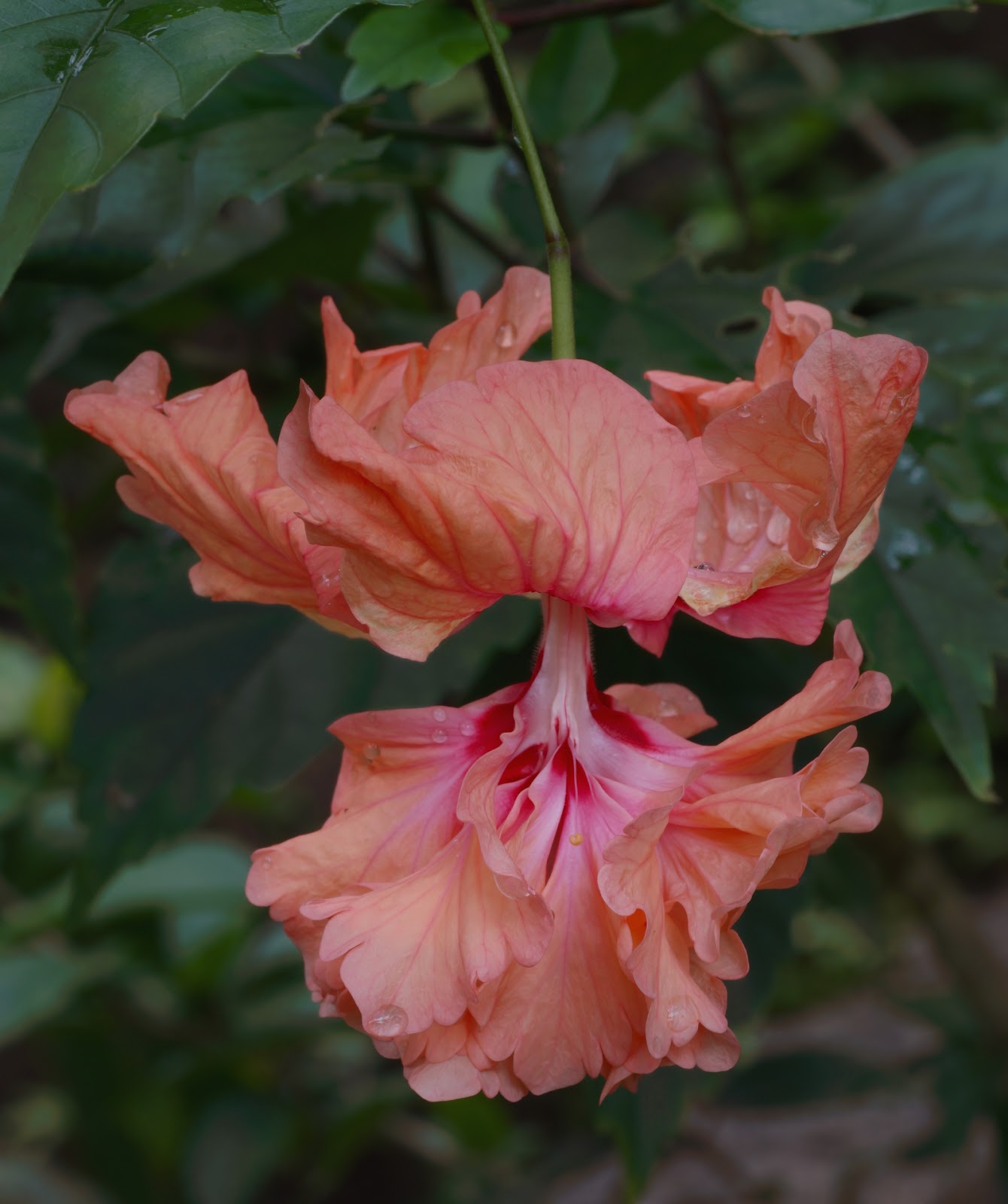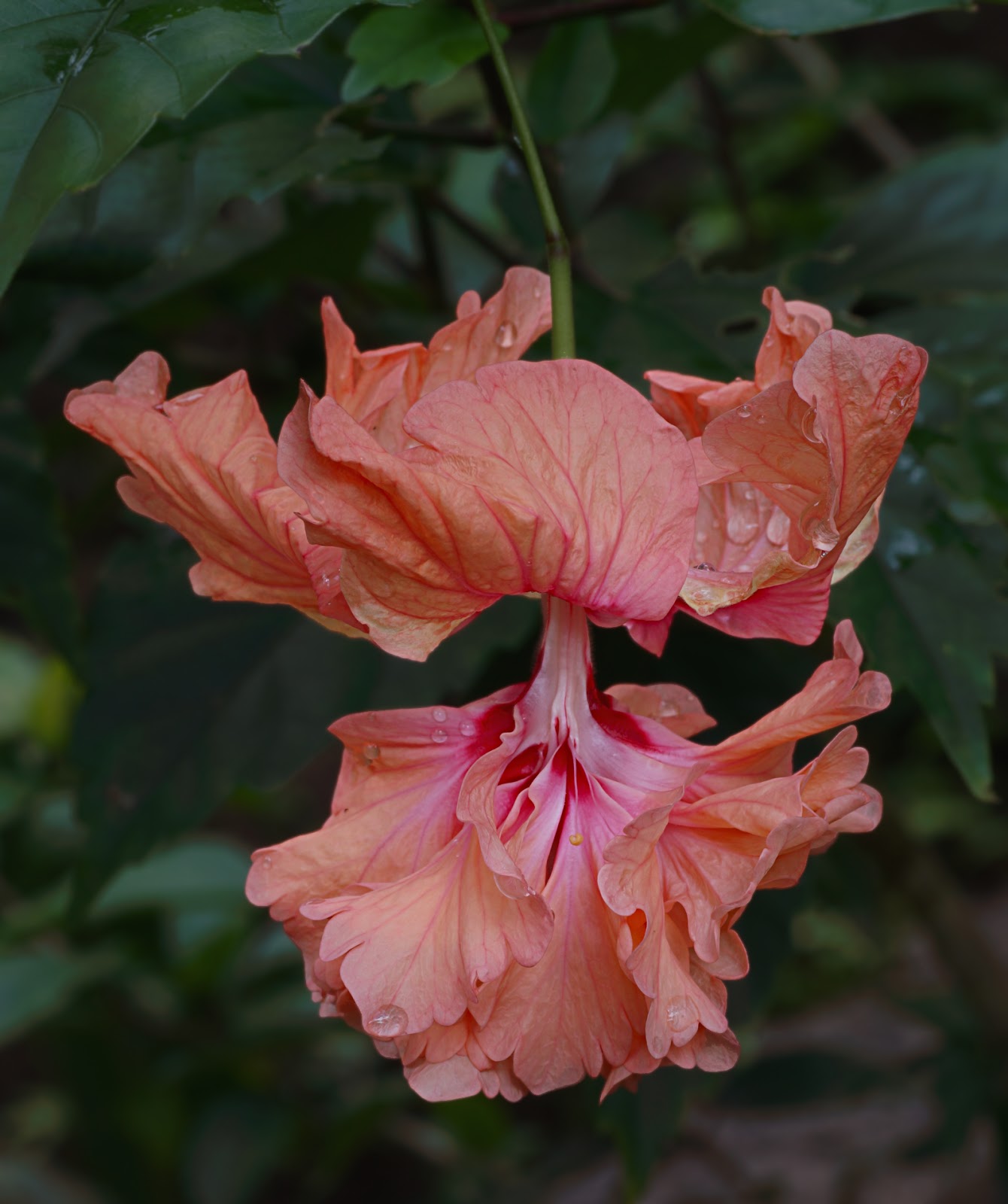Results 1 to 15 of 15
Thread: Hibiscus after the rain
-
3rd January 2018, 04:21 AM #1

- Join Date
- Oct 2013
- Location
- Philippines
- Posts
- 12,181
- Real Name
- Brian
Hibiscus after the rain
-
3rd January 2018, 09:54 AM #2
-
3rd January 2018, 12:30 PM #3

- Join Date
- Oct 2013
- Location
- Philippines
- Posts
- 12,181
- Real Name
- Brian
-
3rd January 2018, 01:19 PM #4
Re: Hibiscus after the rain
A nice composition, but a rather drab tonal range. Just for discussion, here is a simple edit. I pulled the white point down with a levels tool to increase dynamic range. I selected the flower and gave it some additional contrast using a curves tool. I didn't want to emphasize the background, so I did it only to the flower. I then copied and inverted that same mask to another levels tool and darkened the background. Just a quick and dirty, but see what you think of this direction. These are edits one can do with to a jpeg, and I assume gimp has the other tools: curves, levels, and masks.

-
3rd January 2018, 01:42 PM #5
-
3rd January 2018, 02:07 PM #6

- Join Date
- Oct 2013
- Location
- Philippines
- Posts
- 12,181
- Real Name
- Brian
-
3rd January 2018, 02:10 PM #7

- Join Date
- Oct 2013
- Location
- Philippines
- Posts
- 12,181
- Real Name
- Brian
-
3rd January 2018, 02:21 PM #8
Re: Hibiscus after the rain
I would too. I almost never shoot in JPEG. However, the types of edits that Andre and I suggested aren't dependent on raw/JEPG or the specific software. BTW, I agree with him about local contrast, and I would have added that too if I had done a more complete edit. The only one of these edits that is likely to be substantially different in different software packages is local contrast. In many editors, one does this with unsharp mask. For a really nice explanation of how to do this, see https://luminous-landscape.com/contrast-enhancement/. In Lightroom, there is no unsharp mask, but the clarity slider does something quite similar. The Nik "structure" adjustment is somewhat similar too. But I think most pixel editors should give you levels, curves, masks, and unsharp mask, which is all you need for these edits.
-
3rd January 2018, 02:54 PM #9
-
3rd January 2018, 03:25 PM #10
Re: Hibiscus after the rain
I shoot a lot of jpeg and a lot of my posts on other sites are virtually all SOOC jpegs. I measure my success as a photographer when I can get my general images looking great with minimal intervention.
Minor tweaks like the ones done by Dan and Andre are absolutely doable to a jpeg. The downside of a jpeg is that there is less data, so the subtlety can sometimes be lost, but more commonly we start seeing artifacts that would not show up if we are using raw data when we push the image too hard.
-
4th January 2018, 02:25 AM #11

- Join Date
- Oct 2013
- Location
- Philippines
- Posts
- 12,181
- Real Name
- Brian
-
4th January 2018, 03:12 AM #12

- Join Date
- Dec 2017
- Location
- Lulu Island BC Canada
- Posts
- 177
- Real Name
- Art
-
4th January 2018, 04:40 AM #13

- Join Date
- Oct 2013
- Location
- Philippines
- Posts
- 12,181
- Real Name
- Brian
Re: Hibiscus after the rain
I agree with Oscar Wilde: Do what pleases you as long as it doesn't scare the animals. (or words to that effect)
-
4th January 2018, 02:26 PM #14
-
4th January 2018, 02:49 PM #15
Re: Hibiscus after the rain
To each his own. After all, for most of us, this is a hobby, and we are in it for enjoyment, so whatever one enjoys is what one should do. However, just for clarity, you're processing your photos too, just with less control that you could have. Much of your processing comes when you choose those settings. When you do, you are selecting a fixed post-processing menu: a certain amount of saturation, a certain amount of contrast, a white balance, etc. These recipes are designed to work reasonably well with a large proportion of photos, and they do well enough, under some circumstances. However, they are not in any way adjusted for the specifics of a given image, and they apply all of the adjustments globally--to the entire image--whether that is desirable or not. For example, they will sharpen the background as much as the subject. Your mac program allows you to make modest adjustments to that after the fact.Having almost no post processing experience doesn't stop me from having an opinion. These new cameras are amazing. I have a few settings in my personal menu that I use to get more vivid and warm photos when needed. Then I shoot jpegs and edit with mac preview. I'm old, my brains tired, and I'd rather be outside taking photos.
When I switched to digital some years ago--not as a young man--I found postprocessing daunting because it can be so complex. Even now, I consider my skills only middling, and there are people on this site whose skills far exceed mine. However, while it was daunting, it was also liberating because I could do so much more to make an image look like I wanted. I'll post a couple of recent examples. Here is a shot I took on the Minuteman trail, the route the British redcoats took between Lexington and Concord on the first day of the American revolution. Much of this is now a park, and the building was an operating tavern at the time of the battle:

Here's the same shot after some editing. Note in particular the interior, which was very poorly illuminated in the original.

Here's another shot I took in Bergen (Norway, not New Jersey ) on a gray and overcast day--very common there. It is drab because that kind of lighting doesn't provide much contrast.
) on a gray and overcast day--very common there. It is drab because that kind of lighting doesn't provide much contrast.

Here's the same shot after some editing. This one took a bit more work.

None of this is to suggest that you should do what I (or anyone else) does. I just wrote this to suggest that you might be surprised--you might enjoy learning to do a bit of postprocessing. If you do, my solution to how daunting it is was to ignore much of what I read--there are always postings of yet more techniques--and focus on a few things at a time. For example, one approach is to start by learning to control tonality and contrast, ignoring the rest, and then move on to other things, one or two at at time.

 Helpful Posts:
Helpful Posts: 

 Reply With Quote
Reply With Quote



